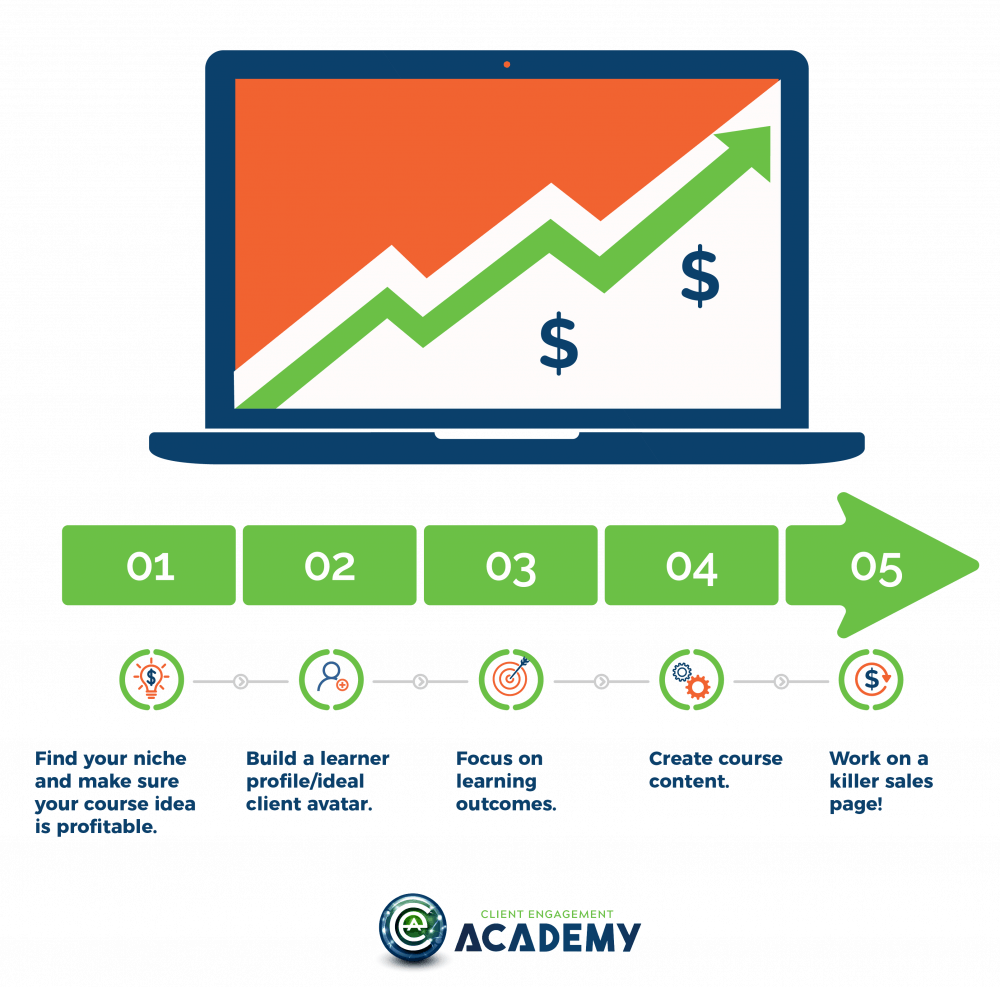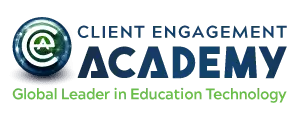
When you’re creating an online course, you need to make sure you’re properly compensated for your hard work.
The best online courses are designed with some success factors “baked in.” This requires thoughtful planning since you’ve got to craft the exact educational experience that your audience wants to buy. Then, of course, you’ve got to deliver that experience.
Don’t make the mistake of skipping these planning steps, or your digital education business will take much longer to gain any traction.
Here are the five steps on the road to paving a profitable and scalable online course business the first time:

1. Find your niche and make sure your course idea is profitable
It’s actually a myth that to create a successful course, you need to pick a broad topic to attract a broad audience. This isn’t true. You actually need to target a specific audience and solve a specific problem for them. That’s how you make a course that sells!
So let’s rewind for just a second. If you want to sell your course, you need to cater to a particular kind of person and attract people who will buy what you have to offer.
The key here is to focus on QUALITY over quantity. You might reach thousands of people with your marketing, but if none of them are interested in what you’re selling, you’re not going to get anywhere.
Narrowing down your audience into a niche is powerful.
Secondly, you need to choose a specific idea—while making sure it’s profitable! You don’t want to spend your time creating a course and then find out no one wants to buy it! Right?
That’s the biggest mistake new course creators make—they don’t make sure that students actually want to learn about the specific topic they chose. No wonder they struggle to attract and engage students later on!
Okay, so when you’re choosing a profitable idea, remember this: if there’s already a course created on the topic you want to create the course, that’s good news! If it has never been done before, that means one of two things: 1) no one out there is interested or 2) people are interested, but nobody is doing it (it might represent an opportunity).
Here’s what you should be asking yourself when you are choosing a topic:
- Are people starting conversations about it? (See what comes up in a Google Search)
- Are people asking other people questions about it? (Check Facebook Groups or Industry Forums)
- Is there something conspicuous missing from what the competition is offering?
How to find a profitable niche in two steps:
Start thinking of something that you’re passionate about. For example: maybe you’re amazing at making web pages and you want to teach people how to use HTML to create web pages of their own. You’ve figured out website creation tips and tricks that you want to share.
Your next step is to head to Google’s KeyWord Planner and search for your topic. (To use the KeyWord Planner, you might have to create an advertising campaign. Go ahead and fill in the information and then put the campaign on pause—you won’t be charged anything.) Go ahead and focus in on a niche that gets at least 1,000 searches per month but which has low competition. For this example, a course on using color in HTML might be a good place to start!
Next, scope out the competition. Type your niche into Google and see what else is out there. For our example, we can see that there are online courses about using colors in HTML, but none on how to design attractive websites using design principles. Here’s our niche!
2. Build a learner profile/ideal client avatar so you fully understand who you’re serving
You’ve got an audience, and you’ve got a solution to their problems. Now it’s time to plan out how to deliver that solution in a memorable and useful way.
If you know anything about marketing, you’ve probably heard of “buyer personas,” or client avatars. Creating a learner profile is very similar, but the focus is on who this hypothetical person is when they come to your course.
Yes, you need to create a course with a specific person in mind. If you think your customer is going to be “everyone,” it will turn out to be “no one.” Big mistake!
Start by putting on your empathy hat. You’ve got to put yourself in your student’s shoes. What are they thinking, feeling, and doing when they’re learning about this topic? What are their goals? You need to understand their frustrations, desires, and needs when you’re creating content because you want to speak to them as directly as possible. When people see that you’ve created something that feels like it’s just for them, they will immediately connect to it!
Now write at least a paragraph describing your ideal student. Continue to keep this person in mind as you go through the rest of this guide.
3. Spell out learning outcomes for your course
Now that you know what learners want to get out of your course, you might think you are ready to start creating content. Avoid this mistake!
Before start creating content, work on crafting learning outcomes that will help your learners achieve their goals. This way learners will perceive a tangible value from your course. If your learners understand the value of your course and become able to improve themselves and achieve their goals, they will know that their money was worth it.
A learning outcome is a clear and easy-to-understand statement that tells students what they will be able to accomplish after completing the course. Your learners need to be able to envision themselves completing your course without too much of a struggle. Each learning outcome should clearly explain, using measurable verbs, what the learner will know, feel, and be able to do by the end of your course. Remember, there’s a gap between where your students are now and where they want to be. Your product is the bridge!
Answer these questions when you’re planning your learning outcomes:
- What skills will they gain after taking the course?
- What new knowledge will they obtain?
- What feelings will they have moved towards or away from?
Your student needs to understand how your course is going to help them and to do that, they need to understand its learning objectives.
Remember, outcomes must be very specific. Avoid vague ideas such as ‘Become more creative” no one knows what that really means – it’s not specific. Instead, say “Unleash your inner creativity by practicing 2 hours each day ” or “Develop creative problem-solving skills in time for your next project”. No one will pay for a course as vague as “become more creative”. Customers want specific and actionable results.
Again, make sure you’re keeping these exercises in your mind as you design the rest of your course.
4. Create course content, even if you’ve never done any writing or speaking
This part can be the most intimidating. After all, you want your content to be top-notch!
The key to this step is to create a clear outline. To do that, START SMALL.
A lot of people, when creating their first online courses, think that they need to create a sweeping, in-depth course that covers absolutely everything they know. That’s a mistake, and a waste of time—especially if you’re just getting started!
So how do you decide what to cover in each lesson? Look at the problem your course solves. Ask yourself: what are all of the steps people need to take to achieve this goal? Each of those steps will become a lesson.
You know better now than to pack a bunch of content into your course, but you should keep each lesson small and simple, too. Don’t pack too much in, and remember to keep your learning outcomes in mind! (For a short course, lessons should be 5-10 minutes long, and definitely no longer than 20 minutes. After that, students will tune out, even if your delivery is great.)
Once you have an outline completed, creating the content becomes really straightforward. Focus less on production quality and more on teaching valuable content. Give awesome, practical, step-by-step instructions, and students will love your course. They won’t care whether the content is text, audio, or video, though keep in mind that video is the most popular format.
If you decide to go with video, you can record yourself using a camera, or you can create a video of your screen as you go through the slides of a presentation. Both options are equally effective!
5. Work on a killer sales page!
Your sales page (which could also be called your course description, your landing page, or your sales letter) is where you not only describe your course but persuade someone to enroll in it.
You might create the best resource that has ever existed in your niche, but if your sales page doesn’t make that very clear to prospective students, they won’t buy. A strong sales page can prove to your students that it’s the solution they were looking for and the perfect tool to solve their problems.
Here are some considerations:
Pick the perfect headline.
Write a gripping, benefit-driven, and targeted statement. In other words, create interest in your target audience and make sure they know how your course will be of use to them.
Showcase testimonials.
We automatically trust third-party opinions when we’re shopping around, so make sure to include quotes from happy customers.
Include a clear Call to Action.
Your Call to Action, or CTA, is the specific action that you prompt your visitors to take. Maybe that’s “Sign up for our email list!” or “Enroll now!” No matter what your goal is, you need to make sure that students know what to do next if they’re interested in your course.
Show what buyers get.
Buyers, for obvious reasons, like to know exactly what they’re getting when they purchase something. Include the class curriculum on your sales page, as well as a list of any bonus material or extra guides that come as part of the package.
Focus on benefits.
We discussed this a little bit above, but the point needs to be hammered home—instead of focusing on the quantity of your content, focus on how your course will benefit those who purchase it.
For example, if we were writing a sales page for a course designed to help web developers charge higher fees, we could go with the phrase “$997 for a 57-hour course for web developers” or we could say “$997 to teach web developers how to charge higher fees, generate more revenue, and become happier with their development business.” That second one is way better, right? So what are the benefits your course delivers?
What did you learn about creating a profitable online course? How will you be changing your strategy in the future? Let us know in the comments below!

Recent Comments